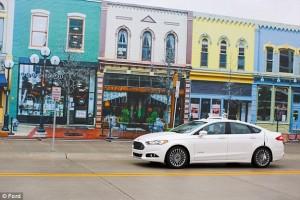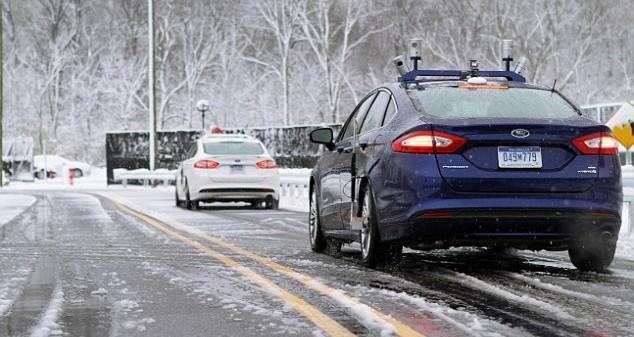 Would you trust your car to drive itself? That is a question that hangs over the auto and tech industries’ efforts to build fleets of autonomous cars like a dark stormcloud, literally. The number of people who would be willing to trust a driverless car is already extremely low, but when you add bad weather or low-sight conditions to the equation that number drops even lower. Even as streets full of driverless cars get closer to being a reality, the general public is still highly resistant to the idea. Even the younger, under-thirty generation doesn’t like the idea, and that demographic usually jumps at the chance to try new technology.
Would you trust your car to drive itself? That is a question that hangs over the auto and tech industries’ efforts to build fleets of autonomous cars like a dark stormcloud, literally. The number of people who would be willing to trust a driverless car is already extremely low, but when you add bad weather or low-sight conditions to the equation that number drops even lower. Even as streets full of driverless cars get closer to being a reality, the general public is still highly resistant to the idea. Even the younger, under-thirty generation doesn’t like the idea, and that demographic usually jumps at the chance to try new technology.
Based on media coverage alone, it may seem like Google is the only player in town looking to make driverless cars happen, but in fact most of the major automobile manufacturers are looking to incorporate some form of the driverless technology into their vehicles. One of the bigger roadblocks to successfully using the technology in real world conditions is the pesky problem of driverless cars becoming practically useless if the weather isn’t perfect. The primary technology used to make driverless cars operate is a high-powered LiDar remote sensing system that uses a bank of lasers to give the car spacial awareness by analyzing the way the lasers reflect off of the surrounding environment. The technology can quickly generate a fully three-dimensional image of the car’s surroundings and under optimal conditions the cars perform almost flawlessly.
Sadly, while a LiDar system can create astonishingly detailed 3D maps that are accurate down to the centimeter, any environmental conditions that block the lasers will prevent it from generating the 3D map. LiDar won’t be able to penetrate most heavy rains, extreme fogs and snow particularly remains a significant challenge to the technology. No matter how good driverless car technology is during optimal driving conditions, when you start adding poor weather conditions like snow, rain or fog the car will become virtually blind and useless. The effect is so bad that the Google-powered cars currently being tested just pull over to the side of the road and wait out the storm.
When 70% of Americans live in regions with snowy or non-optimal weather conditions, that isn’t going to be very popular feature among the commuters that the cars will be targeted at. However, Ford thinks that they are on to an idea that will allow their driverless cars to continue to operate, even under poor, non-optimal weather conditions. Their new system includes the same LiDar technology combined with custom-made, high-resolution 3D maps. But these maps aren’t everyday Google Maps, they are highly detailed maps that include any relevant road-markings, traffic signs, landmarks and even local topography.
Ford recently posted a video online showing a series of road tests of a Ford Fusion Hybrid equipped with their new driverless car technology in snowy and poor visibility conditions. Their car successfully drove itself through the streets of Mcity, the 32-acre artificial city located at the University of Michigan in the Mobility Transformation Centre. Mcity is laid out like an average town and includes just about any city driving obstacles that can be imagined. Not to mention the fact that it is located in Detroit, so poor winter weather conditions don’t need to be simulated, they are a daily occurrence. The combination of LiDar and the 3D maps allows the car to see while navigating thick snow and effectively even through snowbanks that may be obscuring local landmarks.
You can check out the Ford driverless cars being tested in the snow here:
While these early tests are highly encouraging, and the technology involved is really cool, i’m not sure how much it actually solves the main problem of people not trusting the driverless car to not kill them. Just like the street maps that we currently use today, they are generated by combining satellite imagery, GPS and high-power sensors on tests cars that drive all over the country. That means that any changes to streets to local topography will potentially cause problems with a car navigating an out-dated road under harsh weather conditions.
While it’s true that the 3D maps used by Ford are of a far higher quality than typical computer generated maps, the rest of the country isn’t equipped with maps of that quality. Obtaining them, and maintaining a database of them, is going to be extremely costly, and only serve to drive the cost of self-driving cars even higher than they already are. Tell us your thoughts on Ford’s new plan for mapping technology in the 3D Maps in Ford’s Driverless Cars forum over at 3DPB.
Subscribe to Our Email Newsletter
Stay up-to-date on all the latest news from the 3D printing industry and receive information and offers from third party vendors.
You May Also Like
IperionX Inks 10-Year Deal with Wisconsin Manufacturer for 80 Metric Tons of Titanium Per Year
IperionX, the Charlotte-based supplier of sustainable titanium powders used for additive manufacturing (AM) and metal injection molding (MIM), has signed a ten-year deal with United Stars, a group of industrial...
Gastronology Launches Industrial Production of 3D Printed Food for Dysphagia Patients
Food 3D printing has, in many ways, been an additive manufacturing (AM) segment looking for the right business case. While some applications are beautiful and others may or may not...
Lockheed Martin Leads $3M Investment in Q5D’s Electronics 3D Printing System
Q5D, an original equipment manufacturer (OEM) of robotic arm, hybrid additive manufacturing (AM) systems used for wire harness production, has closed a $3 million investment round. The investment arm of...
3D Printing News Briefs, April 6, 2024: Depowdering, Cybertruck Door Handles, & More
In today’s 3D Printing News Briefs, ioTech’s digital manufacturing CLAD technology is opening up opportunities for microelectronics and additive manufacturing. Hexagon and Raytheon Technologies commercially released the Simufact Additive Process...


































